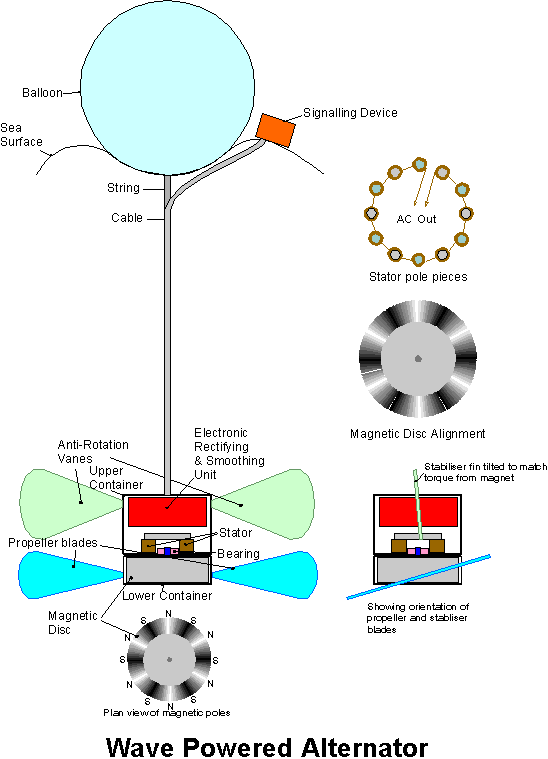
This device is intended to produce a small amount of electricity through wave power. The power generated will typically be between 2 and 5 watts at voltages varying from 6 to 15VAC.
The unit consist of two parts:
1 a balloon which floats on the sea surface.
2 A simple alternator and a rectifying and smoothing unit.
The alternator unit is in two parts. The upper (stator) part is fitted with fins to reduce rotation. A shaft extends from its bottom end into the lower part. The lower part has propeller blades fitted to it and contains a circular magnet unit which is attached to the shaft. It is completely free to rotate in either direction to prevent the cable from being twisted too much.
Coils wound around soft iron pole pieces form an electrical generator stator in the upper part. The circular magnet is rotated in either direction by the propeller. The propeller rotates as the unit is raised and lowered by the balloon which follows the height of the waves. The fins in the upper part can be tilted so that the torque created by the rotating magnet is balanced to reduce or prevent rotation of the upper part.
The alternator uses the same system as that used in Sturmey-Archer hub dynamos once fitted to bicycles. The magnet can be made using modern ceramic ferrites. These can be magnetised in a series of north and south magnetic poles arranged circumferentially during manufacture. Both parts of the unit are in their own sealed containers. This will result in the spacing between the magnet poles and the stator poles being greater than the optimum. However, it is thought that efficient sealing of the two parts of the unit is more critical than close alignment of the magnet and stator. Reliability is considered to be more important than obtaining maximum power output. The output from the stator is fed into a rectifying and smoothing unit. The smoothing unit could make use of small nickel-cadmium cells which would function as an extremely large smoothing capacitor.
The types of the signalling devices powered by this alternator are outside the scope of this design but as a one-time electronics engineer, I offer the following suggestions.
A voltage greater than around 2 volts is sufficient to operate an electronic voltage multiplier circuit that can be used to power either a secondary radar transponder or a xenon strobe flasher or both. Both of these beacons will normally operate intermittently, allowing power to be conserved for occasional strong bursts. For example, a camera flash unit can create the brightness of daylight several feet away momentarily once every 10 to 15 seconds. A simple radio receiver could be included which would respond to nearby transmissions of airborne or seaborne VHF radio. This could be used to trigger the strobe flasher to aid the location of a person floating in the sea.
The alternator can produce more power than batteries of the same weight over a long time period.

Copyright (C) W. H. James 14/6/1998 Wilf James,106 Jarden, Letchworth, Herts. SG6 2NZ, UK. E-mail wilf.james@ntlworld.com